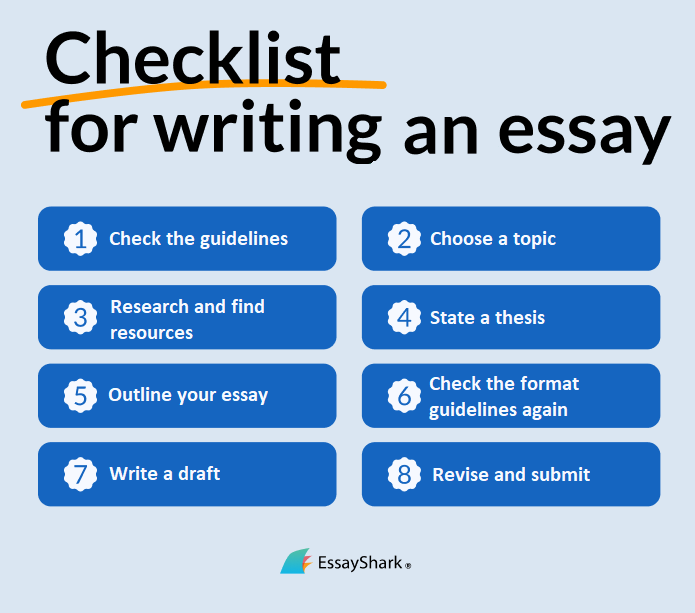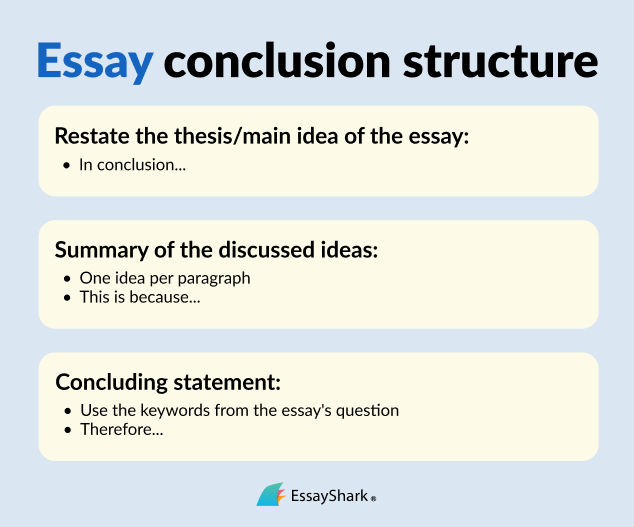In this guide, you’ll learn how to write an essay.
There won’t be vague, meaningless words and phrases you might find in other blog posts on the topic. There will be definite steps, actionable tips, mistakes to avoid, and a how to write an essay example for you to consider.
For those with no time to read, follow these steps or feel free to request “write essay for me” help from our writers:

Table of contents
How to Write an Essay: 8 Steps
- Check the guidelines
- Choose a topic
- Do research and find resources
- State your thesis
- Outline your essay
- Check the formatting guidelines again
- Write a draft
- Revise and submit
Step 1: Check the guidelines
First, read the assignment and ensure that you understand all the requirements. What type of essay are they asking you to write? What are the formatting guidelines to follow? How long should your essay be?
Also, make sure you understand your teacher’s expectations. Are there any extra instructions regarding the topic, recommended sources, depth of analysis, etc. you should consider?
All these will help you compose a stellar essay worthy of a high grade.
Step 2: Choose a topic
If the assignment doesn’t specify a topic, you can brainstorm ideas and choose the subject of your essay. There are three rules to follow:
- Your essay topic should be relevant to the course in question. (There’s no point in writing about music if you get an assignment from a history teacher, but you can write about the history of a particular musical genre and/or its impact on society.)
- Consider your interests and areas of expertise. (It will be easier to research and write about something you know about and are passionate about exploring further.
- Choose a topic with research potential. (Will you find enough resources and evidence to support your arguments in an essay?)
Have no idea what to write about?
Try our essay title generator or check out our massive list of original essay topics to get inspired.
Step 3: Do research and find resources
Now that you have a topic, it’s time to dig deep and find credible and trustworthy resources with evidence and examples. You’ll use them to support your claims and arguments throughout the essay.
How do you know if a resource is credible enough to use?
? NO: Wikipedia pages, article bases a la About.com, user-generated Q&A websites like Ask.com, personal blogs, forums like Reddit, social media posts, newspaper articles
? YES: academic books, scholarly articles, websites ending in .edu or .gov, conference papers, textbooks, journal articles by experts in your field
Step 4: State your thesis
You can only write your essay with a clear thesis statement. Period.
| A thesis statement is a central claim you’ll discuss and prove throughout your essay. It summarizes the main argument you’ll be presenting. |
Ensure that your thesis is:
- Clear
- Specific
- Arguable
Write a sentence or two addressing the position you’ll explore on the topic and place it at the end of your essay’s introduction paragraph.
Step 5: Outline your essay
| An outline is a plan for your future essay, where you structure it and organize the main points and evidence into paragraphs to make it easier for you to write. |
How to write an essay outline?
Keep it short and straightforward—write down 1-2 sentences outlining what you’ll cover in each paragraph: an argument, evidence, and the examples you’ll use. The outline will be your roadmap, ensuring that you stay organized and don’t miss anything while writing.
Step 6: Check the formatting guidelines again
Are there any specific requirements from your teacher concerning the essay’s structure? What citation format should you follow when writing?
Recheck the assignment and make sure your essay outline addresses all the requirements, including the type of essay you have to write. Doing that before writing a draft will save you time and nerves that would otherwise be spent on editing.
Step 7: Write a draft
Start writing your essay: Fill in each section of your outline, adding details, supporting arguments, and evidence to your points.
Write one section at a time. When it’s hard to start writing, it’s okay to write an essay’s body paragraphs first and then return to the introductory paragraph later. Remember to check back with your thesis and outline as you go to stay focused and ensure you don’t miss anything.
Below, you’ll find details on how to write an essay section by section.
| * How to write an introduction for an essay * How to craft an essay body * How to write a conclusion for an essay |
Step 8: Revise and submit
The final step before submitting an essay is its precise revision. Proofread and edit your draft:
- Review it as a whole: Are your arguments coherent and logical? Reorder and rephrase if necessary.
- Refine the language and style: Clarify your points, vary the sentence structures, eliminate any wordy and meaningless phrases, and check the transitions between paragraphs.
- Check for spelling, grammatical, and punctuation errors.
?TIP: Read your essay out loud to “hear” all inaccuracies.
?TIP 2: Revise your essay the day after writing it. Your brain will have had the chance to rest and recharge, and you’ll be able to spot the mistakes you missed.
?TIP 3: Ask a friend or a family member to read your essay. By doing so, you’ll receive feedback from different perspectives and see if something still needs improvement.
How to Write an Introduction for an Essay
- Start with a compelling hook
- Provide background information
- Conclude with your thesis statement

Summarize all the ideas and arguments you covered in the essay’s body to show how you proved the thesis.
Finish with a sentence or two sharing your final remarks about the topic to leave readers with a positive impression.
?TIP: Avoid using phrases like “In conclusion,” “To sum up,” etc. in your last paragraph. Readers aren’t stupid, and they understand that it’s a conclusion. Don’t irritate them.
?TIP 2: Feel free to start a concluding paragraph with a synthesis of your main points and then present the restatement of your thesis.
?TIP 3: Make your final sentence the most impressive one so that readers remember your work. Leave them with food for thought: Ask a question or encourage them to continue learning about the topic.
The 20 Most Common Essay Types
The structure and format of your essay may vary depending on the type of essay your teacher assigns. Please consider the purpose and specifics of your assigned paper to craft it according to all academic standards:
| Essay Type | Specifics |
| Argumentative essays | Wondering how to write an argumentative essay? Aim to persuade the reader to agree with your point of view. Use both arguments and counterarguments in your essay. Check out our argumentative essay topics to better understand what to cover in such papers. |
| Persuasive essays | Use arguments with solid evidence to convince readers of your point of view. These essays are like argumentative ones, but you don’t cover counterarguments to your thesis here. Choose a side and persuade the audience that you are right. |
| Process essays | Explain how something works or how to do something. Guide readers through the process by giving them a step-by-step explanation. |
| Expository essays | This is how to write an expository essay: Explore and explain a specific topic, process, or idea to readers objectively. No emotions and no opinions here – only logic and facts. |
| Descriptive essays | Use creative writing to describe something – a person, place, object, emotion, experience, situation, etc. |
| Analytical essays | Here’s how to write an analytical essay: Examine a given object/subject (a text, book, event), analyze its components, and share your insights on it. |
| Definition essays | Structure your paper around defining a term, concept, or idea. |
| Compare and contrast essays | Analyze the similarities and differences between two subjects in the same category. |
| Narrative essays | Tell a story from your point of view, providing specific and emotional details to engage readers and make them relate to it. Use a storytelling technique, and feel free to check out our narrative essay topics for inspiration. |
| Cause and effect essays | Explain the relationships between specific conditions and their consequences. |
| Critical essays | Analyze and evaluate a text, making a claim about its particular ideas and supporting that claim with evidence. |
| Informative essays | How to write an informative essay: Educate readers about your topic (a concept, an event, a subject, whatever) by providing information based on facts from reliable sources. |
| Problem and solution essays | Describe a problem and present the solution(s) to it. |
| Reflective essays | Describe, analyze, and evaluate your experience with a particular topic: a book you read, a movie you watched, your impressions from something, etc. It’s like a diary but in a more formal, academic format and tone. |
| Personal essays | Write about a significant event from your life and a lesson you learned from it. Such essays are like creative nonfiction. |
| Synthesis essay | Gather information about your topic from several resources, form a thesis based on it, and explain or argue it to readers. Important: Don’t repeat the opinions from your sources; use them to synthesize a new one. |
| Admission essays | You write these essays as part of the application process when entering college. Craft a personal statement, providing insights into your motivations and values so that admission officers understand you better. Check out some topics for admission essays to get ideas on what to write about. |
| Rhetorical analysis essays | Analyze a text in terms of the author’s rhetoric: What were their goals? What writing techniques did they use to appeal to the audience? What arguments did they use to be convincing? How did they structure that text in order to influence readers? |
| Classification essays | Arrange subjects into categories based on their characteristics. Use one organizing principle. For example, if you’re classifying types of movies, you can do it by genre, period, character types, etc. |
| Dialectic essays | Craft a debate in your essay, using arguments and counterarguments to prove your thesis. You’ll need 2-3 opposing arguments to organize a “dialogue” on the topic in your paper. |
Mistakes to Avoid in Essay Writing
When looking for tips on how to write an essay, students also want to know the most common mistakes to avoid in their texts. Here they are:
- No thesis statement (or a meaningless, non-specific one)
- Plagiarism (scan your drafts using a plagiarism checker and an AI detector for essays to prevent duplications or artificial text patterns)
- Grammatical mistakes (“you’re” vs. “your”, “it’s” vs. “its”, “their” vs. “there’re”, incomplete sentences and subject/verb disagreement are the most common ones)
- Using the first person (I, we) instead of third person (he, she, it, they)
- Overuse of passive verbs and redundant adverbs
- Poor punctuation (comma splicing, missing or unnecessary commas, etc.)
- Too many typos
- Incorrect formatting
- Citing non-credible resources (a poor bibliography)
- Using too many quotes (poor referencing)
- Poor essay structuring
- Overly complex structures that makes an essay hard to read
- Vague arguments with no evidence
- Too much information
- No transitions between paragraphs
- A weak conclusion with no final thought (or introducing new information in the conclusion)
- Repeating your introduction in the conclusion
- An inconsistent tone
- Informal language
- Misunderstanding the assignment (writing the wrong type of essay or answering the wrong question)
Choosing Credible Sources for Your Essay
How to write an essay with no scholarly sources in your reference list? Easy:
There’s no way to do it.
The facts and arguments in your text should be confirmed and proven by a credible, trustworthy source. How do you know they are credible enough (and therefore okay) to use in your essay?
- Take information from websites ending in .edu and .gov
- Use scholarly articles, books, publications, and videos
- Consider statistical studies, publications of well-known media outlets, and reports from conferences
Where can you find credible sources for your academic research?
Rather than scrolling through dozens of pages of search results, turn to these:
- Google Scholar: This database provides free access to scholarly research, academic articles, and studies in different fields. You’ll find abstracts and full documents here and can create your school library.
- Google Books: With over 40 million books in its database, this resource will help you find both recent publications and out-of-print books.
- Library of Congress: The most extensive library in the world, it is the perfect resource for academic research. Search it for digital resources, maps, audio recordings, photos, etc..
- JSTOR: One of the best online resources for academic research. Its database focuses on the humanities and social sciences and includes journal articles, books, and images in 70+ disciplines.
- PubMed Central: A resource of the National Library of Medicine (the American National Institutes of Health), offering free access to scholarly literature. Use it to find credible data on the life sciences and different medical fields.
- Research Gate: A social network for research scientists where they upload their work with public access. Over 135 million scientific publications are already there, and you can use this resource to connect with scholars to answer any questions you may have.
- Your University Library: Go to your campus library for reliable sources. Apart from books and journal articles, it also has online databases where you can find rare documents with insights you can use in your paper.
When deciding which scholarly source to use in your essay, consider these five characteristics:
- Publisher: Who’s the owner of the scholarly resource you will use? What website published it? Check this information to distinguish between current and outdated (or professional and commercial) materials.
- Author: Consider the author’s qualifications and other works to determine whether they have enough expertise to be worthy of trust.
- Accuracy: See if your chosen sources include additional references that can also serve as sources. This will help you double-check the presented data before you decide whether or not to use it.
- Bias: Choose sources based on facts and statistics, not opinions; consider those that appeal to logic rather than readers’ emotions.
- Terms: Check the publishing date and avoid using scholarly resources created over five years ago. Their information can be outdated. Of course, this rule might not apply to specific topics or disciplines where “old” books may serve as sources.
Essay Formatting: 3 Core Styles
When speaking about essay formatting, we mean taking a particular approach to citing references in academic papers. All citation styles are standardized, with specific rules and guidelines to follow. Regarding how to write an essay format, there are three core formatting styles: APA, MLA, and Chicago. Let’s see what each of them represents.
| APA | MLA | Chicago |
| BusinessPsychologyEconomicsLawSociologyEducationPolitical science Call your source page “References” | ArtHistoryGeographyLiteratureLinguisticsPhilosophyReligious education Call your source page “Works cited” | AnthropologyMusicTheaterInternational studiesCriminologyReligionComputer science Call your source page “Bibliography” |
The format you use doesn’t depend on the topic you are given in the assignment or get via an essay prompt generator; it depends on the discipline, essay type, and/or specific assignment requirements.
How to Write an Essay in APA
APA (American Psychological Association) is a system created to unify the formatting of entries for reference lists in papers. When you format an essay in APA, each entry in your references will include seven elements:
- Author
- Source title
- Container title
- Version
- Number
- Publisher
- Publication date and location
For example:
Warburton, N. (2006). The basics of essay writing. London: Routledge Taylor & Francis Group.
There are also rules concerning italicization and the placement of punctuation in entries. The APA style prescribes specific formatting rules for different types of sources: periodicals, journal articles, newspapers, books, web sources, etc.
| Check out our presentation with a detailed guide on formatting in APA: CLICK |
MLA Citation Style
The MLA (Modern Language Association) format is for academic papers in the humanities or liberal arts. Like APA, it prescribes rules for formatting entries in your reference lists. When you format an essay in MLA, each entry in your references will include seven elements:
- Author
- Source title
- Container title
- Version
- Number
- Publisher
- Publication date and location
For example:
Rand, Ayn. For the New Intellectual: The Philosophy of Ayn Rand. Random House. 1961.
The core differences between MLA and APA concern formatting the author’s initials, capitalizing each word of the source title, and placing the publication date.
| Check out our presentation with a detailed guide on formatting in MLA: CLICK |
Chicago Format
The Chicago Manual of Style (CMOS) is less common for college essays than MLA or APA, but students may still face it in the requirements for their assigned papers.
When you format an essay in Chicago, each entry in your references will include seven elements:
- Author
- Source title
- Container title
- Version
- Number
- Publisher
- Publication date and location
Unlike APA and MLA, Chicago allows writers to reference their sources with the help of footnotes and endnotes. The standard requirements for formatting entries in bibliographies resemble those of MLA.
How to write a book title in an essay in Chicago format:
Vargoshe, Richard, and Peter Steinberg. The Household Book of Animal Medicine. Englewood Cliffs: Prentice-Hall, 1980.
| Check out our presentation with a detailed guide on formatting in Chicago: CLICK |
Good Topics for Different Essays
Below is a short list of topics for different essay types to inspire you and help you understand how to write an essay. (They are examples of what you can write about in your work.) We’ve also gathered the worst essay topics for college so that you can better distinguish between promising and unworthy themes to cover. Those that are linked are okay to consider how to write an essay example: They’ll help you see the structure and elements to use in your papers.
| Essay | Topic ideas |
| Argumentative | Should we censor photo exhibitions?Pros and cons of cloning extinct species |
| Persuasive | Are beauty contests a good thing for young girls?Does computer gaming addiction lead to more dangerous consequences among children or adults? |
| Process | How to live through a boring lectureHow to read a book in 15 minutes |
| Expository | How writers can influence readersWhat are the symptoms of shopping addiction? |
| Descriptive | My worst nightmareMy teenage diary |
| Analytical | Why are dreams essential in our lives? Change of perception based on attractiveness |
| Definition | |
| Compare and contrast | Civilization vs. Animal InstinctLaptops vs. Desktops |
| Narrative | When did you realize that Santa didn’t exist?Why I decided to move out of my parent’s house |
| Cause and effect | Did the Industrial Revolution lead to a sexual revolution? How does paternalism affect a child’s worldview? |
| Critical | What role does religion play in the novel “The Kite Runner?”On the “Wonder Woman” movie and feminism |
| Problem and solution | How to guarantee justice for all in the USAHow to impress colleagues at your new workplace |
| Admission essays | Why is [university] the perfect place to prepare you for your future career?How do I imagine Earth in the 22nd century? |
Essay Writing Tricks From Students
That’s All, Folks!
We hope this guide has answered all your questions on how to write an essay and helped you understand all the critical aspects of essay writing. You can use our scholarship essay writing service if you still need to be 100% sure about your writing skills. We are here 24/7 to assist you. Just ask!
Photo by JessBaileyDesign from Pixabay








